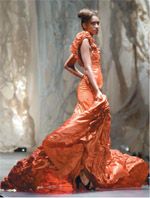Young fashion designer translates cancer fears into fierce frocks
In the fashion world, the word fabulous is tossed around like bolts of fabric at a blowout sale. In the cancer treatment world, fabulous is not a common interjection. And when fashion design student Hattie Saltonstall was confronted with the disease, she felt far from fabulous.
In the fashion world, the word fabulous is tossed around like bolts of fabric at a blowout sale. In the cancer treatment world, fabulous is not a common interjection. And when fashion design student Hattie Saltonstall was confronted with the disease, she felt far from fabulous.
“About a year ago, my mom was diagnosed with breast cancer,” Ms. Saltonstall told ONI. “About 2 weeks after I’d gone home to be with my mom, my godmother called and told me that she’d been diagnosed with liver cancer.” The 24-year-old, who recently graduated from the Savannah College of Art and Design in Georgia, sought a way to wrap her mind around the devastating news.
“I started to research cancer. I forced myself to look at gross pictures, just very disturbing pictures,” she explained. “But instead of looking at the image the way it was, I tried to be an artist about it. I found such beautiful colors and designs. I thought, ‘If I can look at something that is so deadly and so evil, and find a glimpse of beauty in it, then I can find some kind of hope.’”
The result was “Ascendency,” Ms. Saltonstall’s collection of gowns inspired by the pathology images. To create the dresses, she took her love of draped fabrics and married it with heat, manipulating the synthetic materials until they took on a lesion-like feel (see photograph).
“I was burning fabrics,” she said, “sticking them in the microwave, the oven, just to see what happened.” Ultimately, she settled on melting the fabrics over molds using a low-heat source. “Some of the dresses have tremendous movement. It looks like the fabric is growing throughout the garment,” she said.
Needless to say, Ms. Saltonstall’s decision to design “cancer dresses” raised a few eyebrows. Anthony Miller, chair of the college’s fashion department, told ONI that his first reaction was “how do you take something like cancer and turn this into a clothing collection? Curiosity got the better of me and as Hattie developed her designs, I could see the beauty in each piece.”

Mr. Miller described the gowns as “conceptual, combining the feminine ideals of the Victorian time period with the reality of cancer. The craftsmanship was innovative.”
Ms. Saltonstall’s godmother passed away in January, but her mother is undergoing treatment and doing well, she said. Fortunately, her mother was able to travel to Savannah in May to see Hattie’s dresses in the college’s senior fashion show.
Ms. Saltonstall said she has no definite plans for the future, but would like to continue a couture-cancer connection.
“I would love to start my own company, have my own collection, and hold galas for cancer charities,” she commented. “I would like to continue to create these garments that can be worn, put on display, or auctioned off.”